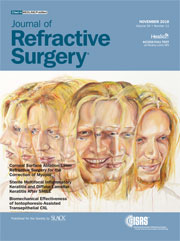Questo studio dimostra come l’uso delle nuove lenti EyeMax migliori la capacità visiva dei pazienti affetti da maculopatia degenerativa mantenendo inalterate le condizioni di sicurezza.
Scott J. Robbie, FRCOphth, PhD; Juan Tabernero, PhD; Pablo Artal, PhD; Muhammad A. Qureshi, FRCS (Ophth).
Journal of Refractive Surgery.
2018;34(11):718-725 https://doi.org/10.3928/1081597X-20180831-01
Abstract
PURPOSE:
To determine the feasibility of a novel intraocular lens (IOL) designed to improve retinal image quality at up to 10° of retinal eccentricity and optionally provide retinal magnification in patients with macular disease.
METHODS:
In this prospective, interventional pilot study, 8 eyes of 7 patients with bilateral dry age-related macular degeneration and 1+ or less cataract underwent phacoemulsification and capsular bag implantation of a single, injectable, hydrophobic acrylic IOL. Safety and efficacy were assessed by monitoring logMAR corrected distance and near visual acuity, intraocular pressure, specular microscopy, 80-point visual field testing, and anterior segment and macular optical coherence tomography at baseline and 1 week, 1 month, and 2 months postoperatively. Microperimetry was undertaken at baseline and 1 and/or 2 months postoperatively. Reading performance was assessed at baseline and 1 month postoperatively using the Minnesota low vision reading chart (MNREAD; Precision Vision, LaSalle, IL).
RESULTS:
Safety outcomes were equivalent to standard monofocal IOLs. Visual acuities improved in all patients. Mean corrected distance visual acuity improved from 0.93 ± 0.22 preoperatively to 0.59 ± 0.25 at 2 months postoperatively. Mean reading speed increased from 28 ± 19 to 44 ± 31 words per minute. Mean microperimetry threshold sensitivities increased from 8.2 ± 4.6 to 12 ± 5.6 dB. Mean percentage of fixation points within a 4° circle increased from 77% ± 17% to 91% ± 11% with evidence for progressive movement of preferred retinal loci away from areas of geographic atrophy.
CONCLUSIONS:
Initial results indicate this novel IOL has a safety profile comparable with standard IOLs. Visual benefits may exceed those obtained with existing technologies in patients with macular disease. Further work is required to determine the full potential of extended macular vision technology.

